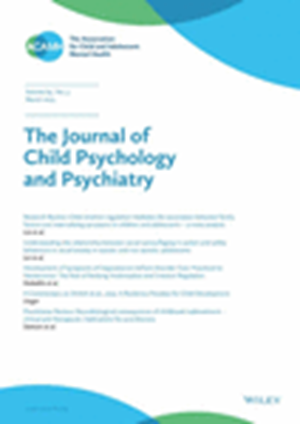Brief digital psychological intervention to prevent relapse of non-suicidal self-injury behavior in adolescents: A randomized controlled trial.
IF 7
1区 医学
Q1 PSYCHIATRY
引用次数: 0
Abstract
BACKGROUND Non-suicidal self-injury (NSSI) poses a significant mental health challenge among adolescents, necessitating accessible and effective interventions. While the development of technology offers new opportunities, higher costs remain a concern. In this context, digital psychological interventions such as text message intervention (SMS) present a convenient and low-cost delivery method that requires no face-to-face contact. However, the extent to which this method could function as a viable strategy remains underexplored. OBJECTIVE To evaluate the effectiveness of an SMS intervention specifically developed for NSSI among adolescents when combined with treatment as usual (TAU), compared to TAU alone. METHODS A randomized controlled trial (RCT) was conducted with 86 Chinese adolescents, randomly assigned to either the SMS intervention plus TAU or TAU alone. The SMS intervention, consisting of text messages addressing NSSI-related knowledge, distress tolerance skills, and emotion regulation strategies, was administered over 8 weeks. Assessments were conducted at baseline, 4 weeks, and 8 weeks. RESULTS Participants in the intervention group showed a significant reduction in NSSI behavior at 4 weeks (RR = 0.43, p < .001), though this effect was not significant at 8 weeks (RR = 0.84, p = .265). No significant changes in NSSI ideation were observed at 4 weeks (RR = 0.87, p = .221) or 8 weeks (RR = 1.10, p = .437). Resistance to NSSI urges increased significantly at 8 weeks in the intervention group (RR = 1.93, p = .002), but not at 4 weeks (RR = 1.44, p = .063). Secondary outcomes showed no significant changes. CONCLUSIONS The low cost, scalability, and accessibility of SMS interventions make them a potentially valuable complementary tool for supporting self-harm populations. However, further research is necessary to confirm their efficacy across diverse settings and to determine how best to integrate them with comprehensive treatment strategies.简短的数字心理干预预防青少年非自杀自伤行为的复发:一项随机对照试验。
背景:非自杀性自伤(NSSI)对青少年的心理健康构成了重大挑战,需要可获得和有效的干预措施。虽然技术的发展提供了新的机会,但更高的成本仍然是一个问题。在这种背景下,短信干预(SMS)等数字心理干预提供了一种方便、低成本、无需面对面接触的传递方法。然而,这种方法作为一种可行战略的作用程度仍未得到充分探讨。目的:评估专门针对青少年自伤开发的SMS干预与常规治疗(TAU)相结合的有效性,并与单独使用TAU进行比较。方法对86名中国青少年进行随机对照试验(RCT),随机分为短信干预加TAU和单独TAU两组。短信干预,包括短信解决自伤相关知识,痛苦容忍技能和情绪调节策略,进行了8周的管理。在基线、4周和8周时进行评估。结果干预组患者自伤行为在第4周显著减少(RR = 0.43, p < 0.05)。0.001),但在8周时效果不显著(RR = 0.84, p = 0.265)。第4周时,自伤意念无明显变化(RR = 0.87, p =)。221)或8周(RR = 1.10, p = .437)。干预组对自伤冲动的抵抗在8周时显著增加(RR = 1.93, p =。002),但在第4周时没有(RR = 1.44, p = 0.063)。次要结局无明显变化。结论短信干预具有低成本、可扩展性和可及性等特点,是支持自残人群的一种有潜在价值的辅助工具。然而,需要进一步的研究来证实它们在不同情况下的疗效,并确定如何最好地将它们与综合治疗策略结合起来。
本文章由计算机程序翻译,如有差异,请以英文原文为准。
求助全文
约1分钟内获得全文
求助全文
来源期刊
CiteScore
13.80
自引率
5.30%
发文量
169
审稿时长
1 months
期刊介绍:
The Journal of Child Psychology and Psychiatry (JCPP) is a highly regarded international publication that focuses on the fields of child and adolescent psychology and psychiatry. It is recognized for publishing top-tier, clinically relevant research across various disciplines related to these areas. JCPP has a broad global readership and covers a diverse range of topics, including:
Epidemiology: Studies on the prevalence and distribution of mental health issues in children and adolescents.
Diagnosis: Research on the identification and classification of childhood disorders.
Treatments: Psychotherapeutic and psychopharmacological interventions for child and adolescent mental health.
Behavior and Cognition: Studies on the behavioral and cognitive aspects of childhood disorders.
Neuroscience and Neurobiology: Research on the neural and biological underpinnings of child mental health.
Genetics: Genetic factors contributing to the development of childhood disorders.
JCPP serves as a platform for integrating empirical research, clinical studies, and high-quality reviews from diverse perspectives, theoretical viewpoints, and disciplines. This interdisciplinary approach is a key feature of the journal, as it fosters a comprehensive understanding of child and adolescent mental health.
The Journal of Child Psychology and Psychiatry is published 12 times a year and is affiliated with the Association for Child and Adolescent Mental Health (ACAMH), which supports the journal's mission to advance knowledge and practice in the field of child and adolescent mental health.

 求助内容:
求助内容: 应助结果提醒方式:
应助结果提醒方式:


